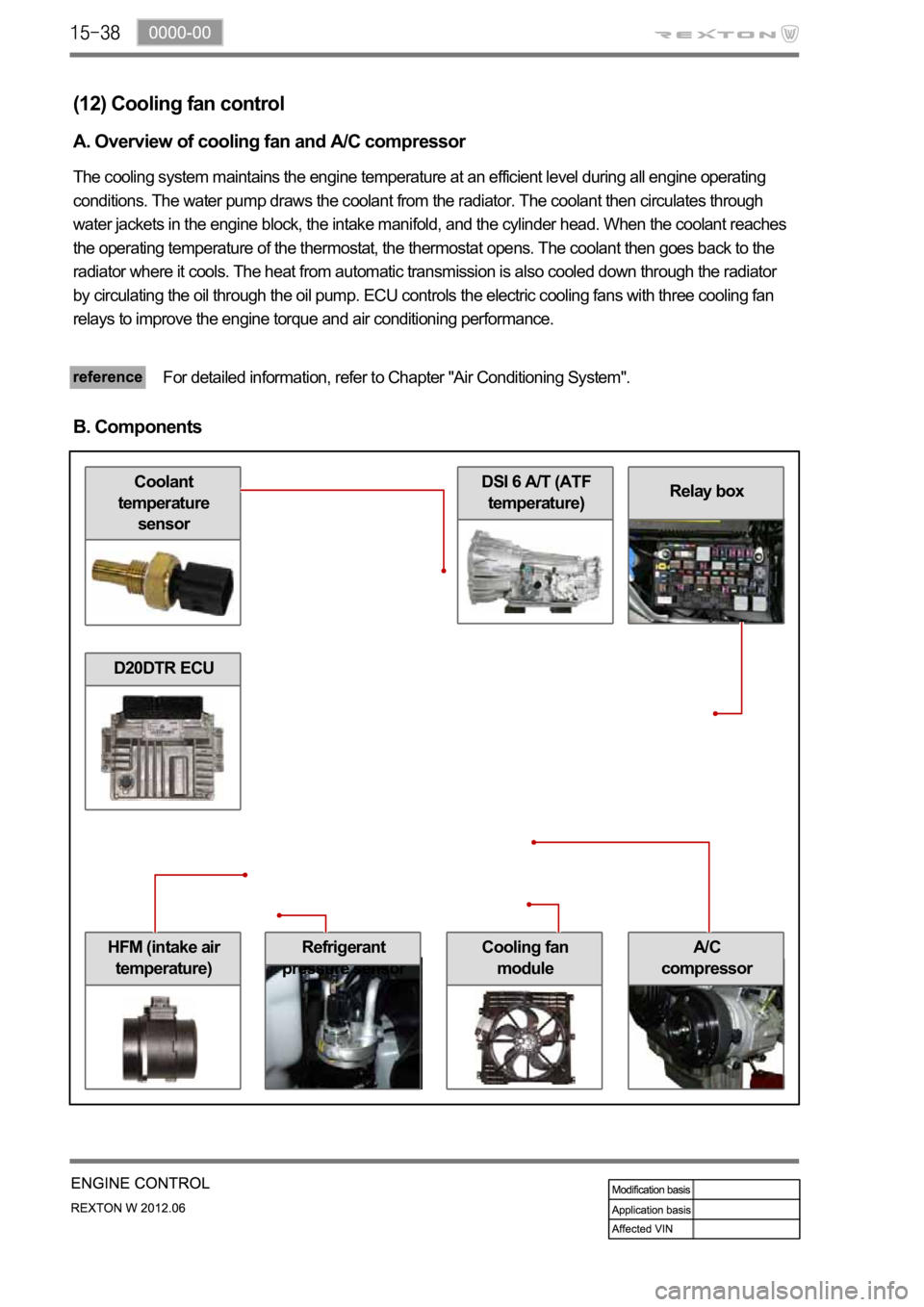SSANGYONG NEW REXTON 2012 Service Manual
NEW REXTON 2012
SSANGYONG
SSANGYONG
https://www.carmanualsonline.info/img/67/57514/w960_57514-0.png
SSANGYONG NEW REXTON 2012 Service Manual
Trending: maintenance schedule, cruise control, oil viscosity, dimensions, length, wiring diagram, automatic transmission
Page 471 of 600
0000-00
C. Input/Output for E-VGT system
Page 472 of 600
D. E-VGT system control
Turbocharger system operates the E-VGT actuator according to the signals for engine epm, accelerator
pedal position, atmospheric pressure, T-MAP, coolant temperature and intake air temperature.
Turbocharger actuator is performed PWM control by ECU.
In general, the boost pressure feedbacks the turbocharger operation and the boost temperature is used
for calculating the precise density.
E-VGT provides higher engine power with faster reaction speed compared to conventional VGT.
Operating wave Vane Control
Low
speed
rangeIn low speed range:
retract the vane to
increase boost
pressure. The vane
has low (-) duty, and
the unison ring
moves to retract the
vane in weak PWM
signal.
High
speed
rangeThe unison ring
moves to extend the
vane in strong PWM
signal. Maximum
pressure is 3 bar and
the system controls it
according to the input
signals.
Page 473 of 600
0000-00
HFM (intake air
temperature)CDPF
Electric throttle
bodyCoolant
temperature
sensorOxygen sensor
Injector (C3I)
E-EGR valve
(11) Wide band oxygen sensor control
A. Overview
For diesel engine, combustion is not performed at the optimum (theoretically correct) air-fuel ratio and
the oxygen concentration is thin in most cases. So the wide-band oxygen sensor is used for this kind of
engine, and this sensor is a little different from the one that used for gasoline engine. The combustion in
diesel engine is controlled by fuel injection volume. Therefore, the wide band oxygen sensor should be
used in diesel engine. This sensor measures the air-fuel ratio in very wide range, and is also called full
range oxygen sensor.
The wide band oxygen sensor measures the oxygen density in exhaust gas and sends it to ECU to
control the EGR more precisely. -
B. Components
D20DTR ECU
Page 474 of 600
C. Input/Output for oxygen sensor
Page 475 of 600
0000-00
D. Oxygen sensor control
The wide band oxygen sensor uses ZnO2. It produces the voltage by movement of oxygen ions when
there is oxygen concentration difference between exhaust gas and atmosphere.
If a certain voltage is applied to the sensor, the movement of oxygen ions occurs regardless of the
oxygen density. The current generated through this flow of ions, is called pumping current (IP), and the
oxygen sensor measures this value.
Page 476 of 600

HFM (intake air
temperature)Cooling fan
module
DSI 6 A/T (ATF
temperature)Coolant
temperature
sensor
Refrigerant
pressure sensor
Relay box
(12) Cooling fan control
A. Overview of cooling fan and A/C compressor
The cooling system maintains the engine temperature at an efficient level during all engine operating
conditions. The water pump draws the coolant from the radiator. The coolant then circulates through
water jackets in the engine block, the intake manifold, and the cylinder head. When the coolant reaches
the operating temperature of the thermostat, the thermostat opens. The coolant then goes back to the
radiator where it cools. The heat from automatic transmission is also cooled down through the radiator
by circulating the oil through the oil pump. ECU controls the electric cooling fans with three cooling fan
relays to improve the engine torque and air conditioning performance.
For detailed information, refer to Chapter "Air Conditioning System".
B. Components
A/C
compressor
D20DTR ECU
Page 477 of 600
0000-00
C. Input/Output for cooling fan and A/C compressor
Page 478 of 600
D. Cooling fan and A/C compressor control
Conditions for cooling fan
The cooling fan module controls the cooling fan relay, high speed relay and low speed relay. The cooling
fan is controlled by the series and parallel circuits.
A/C switch Cooling fanCoolant temperature Refrigerant pressure
A/C
compressor
OFF OFF
-
LO
-
HI
-
ONLO
Refrigerant pressure <
18 bar
ON
HI
pressure
HI
-
HI
-
OFF (cut)
A/C compressor OFF conditions
Approx. 4 seconds after starting the engine
Engine rpm: below 650 rpm or over 4500 rpm
When abrupt acceleration
Refrigerant pressure:
-
-
-
-
-
The output voltage from refrigerant pressure sensor is 1.7 V to 3.5 V when the refrigerant pressure is 10
Output voltage according to refrigerant pressure
Cooling fan controls according to ATF
ATF temperature Fan condition Remark
High speed -
Page 479 of 600
0000-00
(13) PTC heater control
A. Overview
The supplementary electrical heater is installed in DI engine equipped vehicle as a basic equipment. The
PTC system is operated according to two temperature values measured at the coolant temperature
sensor and HFM sensor. This device is mounted in the heater air outlet and increase the temperature of
air to the passenger compartment. Because PTC system is heated by electrical power, high capacity
alternator is required. PTC does not operate during engine cranking, while the battery voltage is lower
than 11 V or during preheating process of glow plugs.
B. Components
HFM (intake air
temperature)
Coolant temperature
sensorPTC heaterD20DTR ECU
PTC 1 relay
PTC 2 relay
PTC 3 relay
PTC Fuse 3 (40A)PTC Fuse 2 (40A)PTC Fuse 1(40A)
Relay box in engine compartment
Page 480 of 600
C. Operation process
The ceramic PTC has a feature that the resistance goes up very high at a certain temperature. There
are three circuits in PTC heater. Only one circuit is connected when PTC1 relay is ON, and two circuits
are connected when PTC2 relay is ON.
Trending: maintenance schedule, jump start, jack points, brake light, fuel type, charging, fuel









